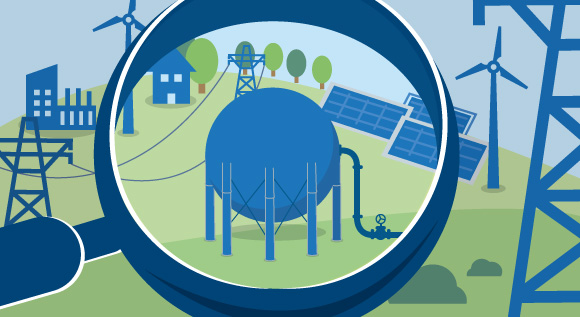What exactly is repowering?
Generating more environmentally friendly electricity with fewer wind turbines, minimising the impact on the environment – Repowering could be another key ingredient in the further expansion of wind energy and it could also become easier to use.
 © BMWi
© BMWi
The key mission: to replace older wind turbines with more efficient and powerful models on existing wind farm sites
Germany’s first wind turbines were installed in the 1990s and have been generating electricity ever since. They have received government funding for at least 20 years. This year, the first of these older installations will see the funding they have received under the Renewable Energy Sources Act discontinued. According to the Renewable Energy Sources Act Progress Report, almost 15 gigawatts (GW) of wind capacity will be affected by this up to 2025, and almost 24 GW by 2030. So what does this mean for the energy transition? Will all these turbines be dismantled, will they go on operating, or will they be replaced by new turbines? The answer is that majority of the old wind turbines is likely to continue operating, as the sale of wind power no longer requires the funding provided under the Renewable Energy Sources Act in order to be profitable. Nevertheless, older installations will at some point reach their expected lifespan.
This opens up new opportunities for the energy transition as, in accordance with the 2021 version of the Renewable Energy Sources Act (EEG 2021), Germany’s installed wind capacity is to be increased from 53 GW in 2019 to 71 GW in 2030. In order to ensure the implementation of the Green Deal – which is to turn Europe into the world’s first climate-neutral continent – this capacity will actually need to be expanded even further. Many believe that repowering could be the solution to this problem. But what exactly is repowering?
'Tuning' wind farms
‘Repowering’ simply means the upgrading of existing power plants or installations. The idea is to replace older turbines or parts of these with modern ones that are more powerful. In principle, this can be done with any type of power plant or installation. Wind power, however, is a technology that is particularly well-suited to repowering. Instead of tuning just one single, older wind turbine, an entire wind farm with a large number of older turbines is dismantled and replaced with more efficient and powerful installations. This means that by repowering existing wind farms, half as many turbines would be able to generate many times more wind power.
Modern wind turbines can have much larger towers and longer rotor blades than the turbines of the past and are thus able to generate much more electricity at fewer rotations per minute. This is also good news for biodiversity: with turbines increasing in size and decreasing in number, their impact on many species of bird is being reduced. In addition to all the technical benefits, repowering is also making an important contribution to the energy transition and helping to raise acceptance for the environmentally-friendly transformation of our energy supply, for example because slower-turning wind turbines are visually more pleasing and calming to the eye than faster rotors and because fewer installations are needed to deliver the same amount of capacity.
EU Member States required to streamline approval procedures for wind power
Even though repowering opens up great opportunities for wind energy, in practice, there are often many bureaucratic hurdles to turbine replacement, not least due to planning and approval rules. The EU’s Renewable Energy Directive (RED II) will now make things easier. For example, it sets out streamlined procedures that the Member States had to implement by the end of June 2021.
In Germany, these rules will be implemented into national law by adding a new paragraph to the Federal Immission Control Act. Up to now, repowering had been treated the same way as new greenfield projects in terms of the nature conservation, biodiversity and noise protection requirements to be met – and this despite the fact that wind turbines meeting these requirements had already been operated at these sites for a very long time. The most important change brought about by the new legislation is that new turbines that create no greater adverse effects or even fewer than the existing turbine will benefit from streamlined approval procedures. The rule is that new wind turbines must not be subjected to much stricter requirements than older models. This could help retired wind turbines to be replaced swiftly.
Why does this make economic sense? Let’s look at the following example: An older wind farm consisting of eight turbines generating around 8 megawatts (MW) of capacity can be dismantled and replaced with three turbines generating around 12 MW of capacity. This means a 50% increase in capacity, but the output will increase even more. Depending on the specific location of the wind farm, the upgraded wind turbines could raise output from 8 to 30 million kilowatt hours (kwh) per year.

